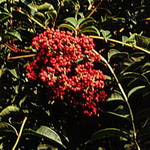| Common Name: |
Tetradium ruticarpum |
| Botanical Name: |
Tetradium ruticarpum syn. Euodia officinalis, E. rutaecarpa. |
| Genus: |
Tetradium |
| Family: |
Rutaceae |
| Cultivation: |
Well-drained soil in sun or partial shade. Remove dead or congested growths in early spring. |
| Propagation: |
By seed sown in autumn; by root cuttings in midwinter. |
| Harvest: |
Fruits are collected when ripe and dried for use in decoctions. |
| Native Location: |
China and Taiwan |
| Height: |
9m (28ft) |
| Width: |
5m (15ft) |
| Hardiness: |
Z9-11 |
| Parts Used: |
Fruits (wu zhu ya) |
| Properties: |
A pungent, bitter, very warming herb that relieves pain, destroys intestinal parasites, stimulates the uterus, controls vomiting, and is anti-bacterial. It increases both body temperature and blood pressure. |
| Medicinal Uses: |
Internally for stomach chills and pains, vomiting and acid regurgitation, diarrhea (especially in early morning), painful menstruation, and threadworm infections. Usually combined with Glycyrrhiza glabra (See, Licorice) to reduce toxicity and with Zingiber officinalis (See, Ginger) for abdominal chills. |
| Warning: |
Fruits are poisonous.
Excess causes diarrhea, dyspepsia, and delirium. |
| Bibliography: |
Encyclopedia of Herbs by Deni Brown. Copyright © 1995, 2001 Dorling Kindersley Limited. pg 385
|

